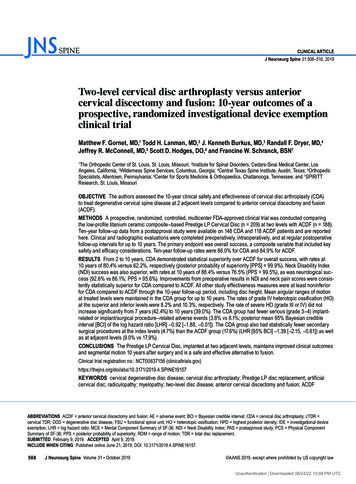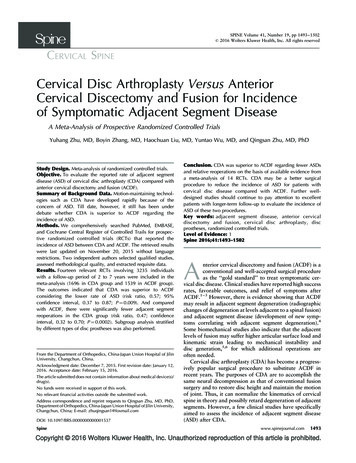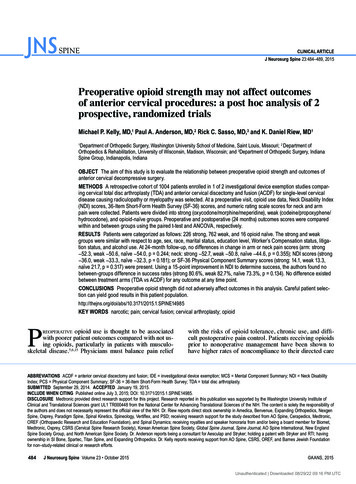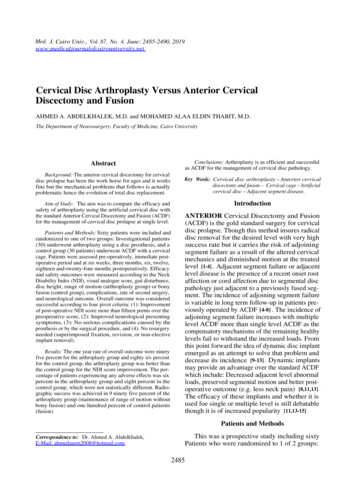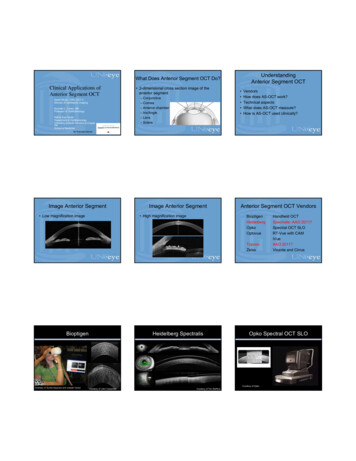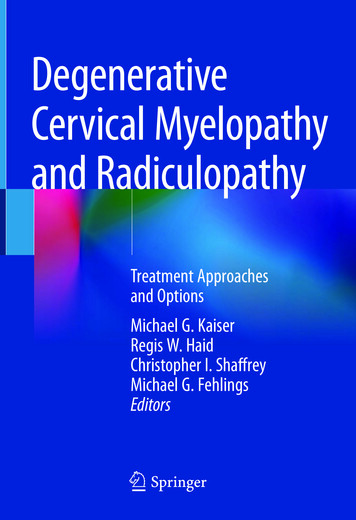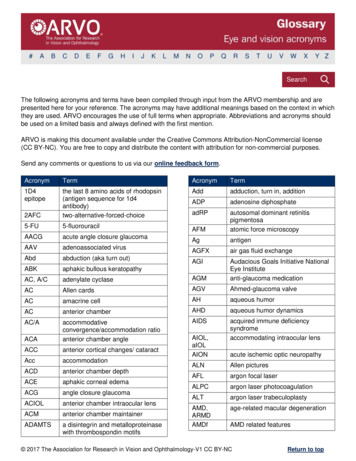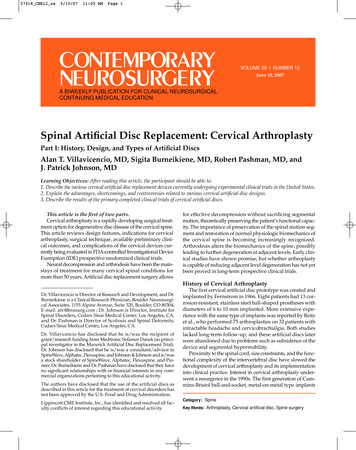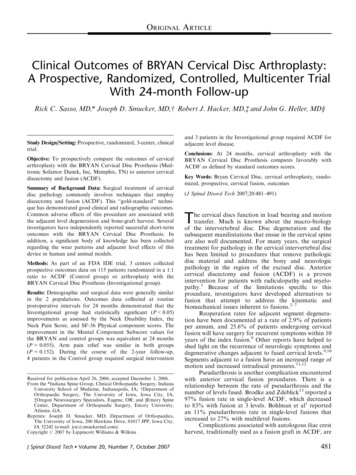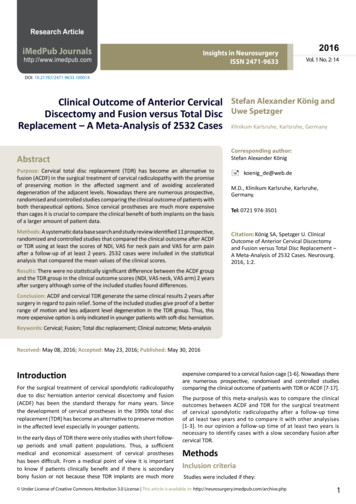
Transcription
Research ArticleiMedPub JournalsInsights in NeurosurgeryISSN 2471-9633http://www.imedpub.com2016Vol. 1 No. 2: 14DOI: 10.21767/2471-9633.100014Clinical Outcome of Anterior CervicalDiscectomy and Fusion versus Total DiscReplacement – A Meta-Analysis of 2532 CasesStefan Alexander König andUwe SpetzgerKlinikum Karlsruhe, Karlsruhe, GermanyCorresponding author:Stefan Alexander KönigAbstractPurpose: Cervical total disc replacement (TDR) has become an alternative tofusion (ACDF) in the surgical treatment of cervical radiculopathy with the promiseof preserving motion in the affected segment and of avoiding accelerateddegeneration of the adjacent levels. Nowadays there are numerous prospective,randomised and controlled studies comparing the clinical outcome of patients withboth therapeutical options. Since cervical prostheses are much more expensivethan cages it is crucial to compare the clinical benefit of both implants on the basisof a larger amount of patient data. Methods: A systematic data base search and study review identified 11 prospective,randomized and controlled studies that compared the clinical outcome after ACDFor TDR using at least the scores of NDI, VAS for neck pain and VAS for arm painafter a follow-up of at least 2 years. 2532 cases were included in the statisticalanalysis that compared the mean values of the clinical scores.Citation: König SA, Spetzger U. ClinicalOutcome of Anterior Cervical Discectomyand Fusion versus Total Disc Replacement –A Meta-Analysis of 2532 Cases. Neurosurg.2016, 1:2.koenig de@web.deM.D., Klinikum Karlsruhe, Karlsruhe,Germany.Tel: 0721 974-3501Results: There were no statistically significant difference between the ACDF groupand the TDR group in the clinical outcome scores (NDI, VAS neck, VAS arm) 2 yearsafter surgery although some of the included studies found differences.Conclusion: ACDF and cervical TDR generate the same clinical results 2 years aftersurgery in regard to pain relief. Some of the included studies give proof of a betterrange of motion and less adjacent level degeneration in the TDR group. Thus, thismore expensive option is only indicated in younger patients with soft-disc herniation.Keywords: Cervical; Fusion; Total disc replacement; Clinical outcome; Meta-analysisReceived: May 08, 2016; Accepted: May 23, 2016; Published: May 30, 2016IntroductionFor the surgical treatment of cervical spondylotic radiculopathydue to disc herniation anterior cervical discectomy and fusion(ACDF) has been the standard therapy for many years. Sincethe development of cervical prostheses in the 1990s total discreplacement (TDR) has become an alternative to preserve motionin the affected level especially in younger patients.In the early days of TDR there were only studies with short followup periods and small patient populations. Thus, a sufficientmedical and economical assessment of cervical prostheseshas been difficult. From a medical point of view it is importantto know if patients clinically benefit and if there is secondarybony fusion or not because these TDR implants are much moreexpensive compared to a cervical fusion cage [1-6]. Nowadays thereare numerous prospective, randomised and controlled studiescomparing the clinical outcome of patients with TDR or ACDF [7-17].The purpose of this meta-analysis was to compare the clinicaloutcomes between ACDF and TDR for the surgical treatmentof cervical spondylotic radiculopathy after a follow-up timeof at least two years and to compare it with other analysises[1-3]. In our opinion a follow-up time of at least two years isnecessary to identify cases with a slow secondary fusion aftercervical TDR.MethodsInclusion criteriaStudies were included if they: Under License of Creative Commons Attribution 3.0 License This article is available in: http://neurosurgery.imedpub.com/archive.php1
ARCHIVOSDE MEDICINAInsightsin NeurosurgeryISSN1698-9465ISSN2471-96332016Vol. 1 No. 2: 14(1)Had a prospective, randomized and controlled study design;(7)Type of fusion;(2)Had a minimum follow-up time of 2 years;(8)Japanese Orthopedic Association (JOA) score;(3)Included patients with cervical spondylotic radiculopathywithout myelopathy;(9)Neck Disability Index (NDI);(4)Included patients 18 years of age.(10)Visual Analogue Scale (VAS) score for neck pain;(11)VAS score for arm pain.Exclusion criteriaStudies were excluded if they:(1)Did not have a prospective, randomized and controlledstudy design,(2)Had a follow-up time of less than 2 years,(3)Included patients with cervical spondylotic myelopathy,(4)Did not use VAS and/or NDI for the measurement ofclinical outcome.Search for and selection of studiesThe authors searched the databases of MEDLINE and theCochrane Central Register of Controlled Trials. There was norestriction regarding the publication date or the language of thepublication.The databases were searched for the terms:(1)Cervical spine OR radiculopathy OR degenerative discdisease OR nerve root compression;(2)Total disc replacement OR prosthesis OR dynamic implant;(3)Fusion OR anterior decompression and fusion OR ACDF;(4)Clinical outcome OR JOA score OR neck disability index ORNDI OR visual analogue scale OR VAS.The main author conducted the search of the databases usingthe search terms mentioned above. Afterwards the titles andabstracts of all search results were reviewed to exclude unrelatedstudies. In the next step all authors reviewed the selectedpublications according to the inclusion and exclusion criteria. Thereviewers were not blinded to the authors or the journal of thestudies. After the first review process all authors reviewed thefull text of all studies that were finally included into the metaanalysis.Data acquisitionThe following data were collected from each study and stored ina tabular form:(1)Study ID;(2)Study design;(3)Number of patients;(4)Patient demographics;(5)Follow-up time;(6)Type of TDR;2Statistical analysisThe statistical data analysis was performed using SPSS Statistics,version 23.0.0.2 (IBM Corporation, Armonk, NY, USA). Mean,standard deviation, standard error of the mean, confidenceinterval, mean differences, standard error of the difference,T-value and two-tailed p-values were calculated. Boxplots weregenerated to visualize the data and mean values from the ACDFand TDR groups (Figures 1-3).ResultsSearch resultsThe search in both databases identified 321 studies. Of thesestudies 279 had to be excluded because they were biomechanicalinvestigations, reviews, meta-analysises, non-human experimentalstudies or case reports.The remaining 42 studies underwent full text review with specialemphasis on the inclusion and exclusion criteria mentionedabove. Finally, 11 studies could be identified that met all of thedefined criteria (Table 1) [7-17].Quality of studiesAll eleven studies were prospective, randomized and controlledtrials. Nine out of the the eleven studies were multicenterstudies. The major baseline characteristics of the patients ineach study (inclusion and exclusion criteria, number of patients,demographics, clinical data) were similar. Thus, the studies wereof relatively high quality.Clinical outcomeThe mean values for the NDI scores were 20.98 (SD 9.59) in theTDR group and 22.71 (SD 8.18) in the ACDF group (Figure 1).There was no significant difference in the NDI scores betweenthe two groups (MD 1.73; 95% CI: 6.65 to 10.10; p 0.670).The mean VAS neck score was lower in the TDR group (20.59;SD 10.39) than in the ACDF group (23.78; SD 9.30; Figure 2) butthere was no significant difference between the two groups (MD3.19; 95% CI: 5.58 to 11.97; p 0.457).The mean VAS arm scores were similar with 18.33 (SD 9.07) inthe TDR group and 19.98 (SD 8.12) in the ACDF group (Figure3). There was also no significant difference between the twogroups in the VAS arm scores (MD 1.65; 95% CI: 6.96 to 10.26;p 0.690).Only one study used the JOA score for the assessemt of clinicaloutcome. Thus, this parameter could not be used for statisticalanalysis.This article is available in: http://neurosurgery.imedpub.com/archive.php
ARCHIVOSDE MEDICINAInsightsin ,0025,0025,00Vol. 1 No. 2: 14o9NDI TDRNDI ACDF35,00201620,0020,0015,0015,0010,0010,00Figure 1 Boxplots for the postoperative NDI scores comparing the clinical outcome after ACDF and TDR.35,0035,0030,0030,0025,0025,0020,00VAS neck TDRNDI ACDFFigure 1 Boxplots for the postoperative NDI scores comparing the clinical outcome after ACDF and TDR.20,0015,0015,0010,0010,00Figure 2 Boxplots for the postoperative VAS scores for neck pain comparing the clinical outcome after ACDF and TDR.Figure 2 Boxplots for the postoperative VAS scores for neck pain comparing the clinical outcome after ACDF and TDR.DiscussionUp to date numerous prospective, randomized and controlledstudies have been published that compare the clinicaloutcome two or more years after surgical treatment of cervicalradiculopathy by either ACDF or TDR [7-17]. Thus, a decidedanalysis of higher case numbers with a conclusion about theclinical benefit of the relatively expensive cervical prostheses hasbecome possible.The statistical analysis of the NDI as well as the VAS for arm andneck pain after a follow-up of at least 24 months did not showany significant difference between ACDF and TDR. This result iscongruent to some of the studies that were included into themeta-analysis [8, 9, 11, 15, 17]. Given the large SDs the statistical Under License of Creative Commons Attribution 3.0 Licensepower of the analysis is not high, and thus in some of theincluded studies significant improvements were found for TDRof the kind one would expect [7, 12-14, 16]. And in some of theincluded studies there was at least significant proof of a betterrange of motion and/or less degeneration of adjacent levels inthe long-term follow-up as an advantage of TDR [8, 10, 11, 14,15]. Another meta-analysis by Zhang et al. [18] found significantfewer adverse events and fewer secondary surgical procedures.As a consequence of our analysis the comparison of ACDF andTDR shows morphological benefits in the TDR group but an equalclinical outcome at the same time. These results have to be takeninto account when indicating the implantation of a cervical discprosthesis because the costs of such an implant are between fiveto ten times higher compared to a cervical cage. In the authors 3
201630,0030,025,0025,0VAS arm TDRVAS arm ACDFARCHIVOSDE MEDICINAInsightsin NeurosurgeryISSN1698-9465ISSN2471-963320,00Vol. 1 No. 2: 1420,015,0015,010,0010,0Figure 3 Boxplots for the postoperative VAS scores for arm pain comparing the clinical outcome after ACDF and TDR.Figure 3 Boxplots for the postoperative VAS scores for arm pain comparing the clinical outcome after ACDF and TDR.Table 1 Study overview.Study ID,yearStudydesignNumberFollow- Type of TDR, Type of fusion,Patient ageJOAofup time number ofnumber ofstatistics (years)scorepatients(months)patientspatientsNDI atendpointVAS neck atendpointVAS arm atendpointProspectiveSassoRandomizedet al. [1] ControlledMulticenter115TDR: 42.5 ( 7.8)ACDF: 46.1 ( 7.8)24BRYAN (n 56)Fibular allograftand anteriorplate (n 59)-TDR:36ACDF: 35TDR: 36ACDF: 35TDR: 36ACDF: 35ProspectiveMurrey Randomizedet al. [2] ControlledMulticenter209TDR: 42.1 ( 8.4)ACDF: 43.5 ( 7.1)24ProDisc-C (n 103)Allograft boneand plate(n 106)-TDR: 21.4ACDF: 20.5TDR: 36ACDF: 34TDR: 20ACDF: 1847TDR: 40ACDF: 4348Bryan (n 21)Heterologousbone graft(n 26)-TDR: 10.1ACDF: 15.9TDR: 13.6ACDF: 28.1TDR: 10.8ACDF: 21.7269TDR: 43.7 (27-61)ACDF: 43.9 (23-62)24Kineflex/C (n 136)Allograft andplate (n 133)-TDR: 22.6ACDF: 23.4TDR: 23.6ACDF: 24.2(cumulativeneck DR: 44.8 (32-59)ACDF: 45.6 (31-62)24Bryan (n 60)Fibular allograftand anteriorplating (n 60)-TDR: 19.07TDR: 16.20TDR: 14.89 3.76 2.90 5.02ACDF: 15.25 ACDF: 21.45 ACDF: 17.34 3.774.85 4.76ProspectivePhillipsRandomizedet al. [6]Controlled342TDR: 45.3 (18-68)ACDF: 43.7 (20-63)24-TDR: 25ACDF: 30TDR: 28ACDF: 30ProspectiveVaccaro Randomizedet al. [7] ControlledMulticenter380TDR: 47 (30-63)ACDF: 44 (32-62)24SECURE-C (n 240)Allograft andplate (n 140)-TDR: 12ACDF: 16TDR: 14ACDF: 20TDR: 7ACDF: 9ProspectiveBurkus Randomizedet al. [8] ControlledMulticenter541TDR: 43.3 (25-72)ACDF: 43.9 (22-73)84Prestige (n 276)N/A (n 265)-TDR: 18.1ACDF: 23.8TDR: 13.1ACDF: 19.4TDR: 12.7ACDF: 15.0ProspectiveHiseyRandomizedet al. [9] ControlledMulticenter245TDR: 43.3 ( 9.2)ACDF: 44.0 ( 8.2)24Mobi-C (n 164)Allograft boneand plate(n 81)-TDR: 16ACDF: 18TDR: 17.34ACDF: 19.36TDR: 13.6ACDF: 13.5ProspectiveGarridoRandomizedet al. [3]ControlledProspectiveCoricRandomizedet al.[4] ControlledMulticenterZhanget al.[5]4PCM Cervical Allograft andDisc (n 218) plate (n 185)This article is available in: http://neurosurgery.imedpub.com/archive.php
2016ARCHIVOSDE MEDICINAInsightsin hang Randomizedet al. [10] ControlledMulticenterProspectiveSkeppholm Randomizedet al. [11] ControlledMulticenter111TDR: 44.8 (18-68)ACDF: 46.7 (18-68)153TDR: 46.7 ( 6.7)ACDF: 47.0 ( 6.9)48Mobi-C (n 55)TDR:Cage and plate 14.2 TDR: 19.60(n 56)ACDF: ACDF: 20.1014.0TDR: 1.4ACDF: 1.624Discover (n 81)Iliac crest bonegraft (n 70)TDR: 27.4ACDF: 28.6opinion is crucial to indicate TDR only in younger patientswith a soft-disc herniation because the verified advantages ofTDR (preservation of motion and avoidance of adjacent leveldegeneration) are primarly morphological benefits that mighthelp to avoid secondary surgery of adjacent levels as it was Under License of Creative Commons Attribution 3.0 LicenseVol. 1 No. 2: 14-TDR: 39.1ACDF: 40.1TDR: 20.7ACDF: 20.3shown by Zhang et al. [18]. These facts should be included whengiving advises to the patient. Probably it would be helpful if theindustry would produce cervical disc prostheses at a significantlylower price to achieve a higher number of patients being treatedwith TDR to get more experiences with these implants.5
ARCHIVOSDE MEDICINAInsightsin ing D, Shaffrey ME (2012) Cervical disk arthroplasty: Patientselection. Clin Neurosurg 59: 91-97.2Richards O, Choi D, Timothy J (2012) Cervical arthroplasty: Thebeginning, the middle, the end? Br J Neurosurg 26: 2-6.3Tharin S, Benzel EC (2012) Cervical spine arthroplasty: Fact or fiction:The absence of need for arthroplasty. Clin Neurosurg 59: 82-90.4Griva F, Pretti F, Fazio M (2014) Does cervical arthroplasty reduce therate of adjacent segment disease? J Neurosurg Sci 58: 41-44.5Karabag H, Cakmak E, Celik B, Iplikcioglu AC, Soran AF (2014) Arthroplastyversus fusion for single-level cervical disc disease. JPMA The Journalof the Pakistan Medical Association 64: 1348-13516Shriver MF, Lubelski D, Sharma AM, Steinmetz MP, Benzel EC,et al. (2015) Adjacent segment degeneration and disease followingcervical arthroplasty: A systematic review and meta-analysis. TheSpine Journal: Official Journal of the North American Spine Society.7Sasso RC, Smucker JD, Hacker RJ, Heller JG (2007) Clinical outcomesof BRYAN cervical disc arthroplasty: A prospective, randomized,controlled, multicenter trial with 24 month follow-up. Journal ofSpinal Disorders & Techniques 20: 481-491.8Murrey D, Janssen M, Delamarter R, Goldstein J, Zigler J, et al. (2009)Results of the prospective, randomized, controlled multicenter Foodand Drug Administration investigational device exemption study ofthe ProDisc-C total disc replacement versus anterior discectomyand fusion for the treatment of 1-level symptomatic cervical discdisease. The Spine Journal: Official Journal of the North AmericanSpine Society 9: 275-286.9Garrido BJ, Taha TA, Sasso RC (2010) Clinical outcomes of Bryancervical disc arthroplasty a prospective, randomized, controlled,single site trial with 48 month follow-up. Journal of Spinal Disorders& Techniques 23: 367-371.10 Coric D, Nunley PD, Guyer RD, Musante D, Carmody CN, et al. (2011)Prospective, randomized, multicenter study of cervical arthroplasty:269 patients from the Kineflex C artificial disc investigational deviceexemption study with a minimum 2 year follow-up: Clinical article. JNeurosurg Spine 15: 348-358.62016Vol. 1 No. 2: 1411 Zhang X, Zhang X, Chen C, Zhang Y, Wang Z, et al. (2012) Randomized,controlled, multicenter, clinical trial comparing BRYAN cervical discarthroplasty with anterior cervical decompression and fusion inChina. Spine 37: 433-438.12 Phillips FM, Lee JY, Geisler FH, Cappuccino A, Chaput CD, et al.(2013) A prospective, randomized, controlled clinical investigationcomparing PCM cervical disc arthroplasty with anterior cervicaldiscectomy and fusion. 2 year results from the US FDA IDE clinicaltrial. Spine 38: E907-918.13 Vaccaro A, Beutler W, Peppelman W, Marzluff JM, Highsmith J,et al. (2013) Clinical outcomes with selectively constrained SECURE-Ccervical disc arthroplasty: Two year results from a prospective,randomized, controlled, multicenter investigational device exemptionstudy. Spine 38: 2227-2239.14 Burkus JK, Traynelis VC, Haid RW Jr, Mummaneni PV (2014) Clinicaland radiographic analysis of an artificial cervical disc: 7 year followup from the prestige prospective randomized controlled clinical trial:Clinical article. Journal of neurosurgery Spine 21: 516-528.15 Hisey MS, Bae HW, Davis R, Gaede S, Hoffman G, et al. (2014) Multicenter, prospective, randomized, controlled investigational deviceexemption clinical trial comparing Mobi-C Cervical Artificial Disc toanterior discectomy and fusion in the treatment of symptomaticdegenerative disc disease in the cervical spine. International journalof spine surgery 8.16 Zhang HX, Shao YD, Chen Y, Hou Y, Cheng L, et al. (2014) A prospective,randomised, controlled multicentre study comparing cervical discreplacement with anterior cervical decompression and fusion.International orthopaedics 38: 2533-2541.17 Skeppholm M, Lindgren L, Henriques T, Vavruch L, Lofgren H, et al.(2015) The discover artificial disc replacement versus fusion incervical radiculopathy--a randomized controlled outcome trial with2-year follow-up. The Spine Journal: Official Journal of the NorthAmerican Spine Society 15: 1284-1294.18 Zhang Y, Liang C, Tao Y, Zhou X, Li H, et al. (2015) Cervical total discreplacement is superior to anterior cervical decompression andfusion: A meta-analysis of prospective randomized controlled trials.PLoS One 10: e0117826This article is available in: http://neurosurgery.imedpub.com/archive.php
Outcome of Anterior Cervical Discectomy and Fusion versus Total Disc Replacement - A Meta-Analysis of 2532 Cases. Neurosurg. 2016, 1:2. Introduction For the surgical treatment of cervical spondylotic radiculopathy due to disc herniation anterior cervical discectomy and fusion (ACDF) has been the standard therapy for many years. Since
